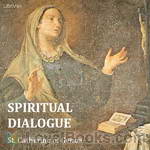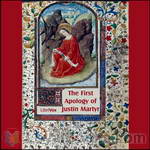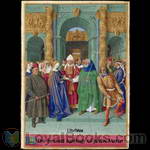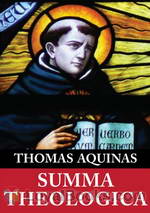|
Books Should Be Free Loyal Books Free Public Domain Audiobooks & eBook Downloads |
|
|
Books Should Be Free Loyal Books Free Public Domain Audiobooks & eBook Downloads |
|
Religion |
|---|
|
Book type:
Sort by:
View by:
|
By: Saint Catherine of Genoa (1447-1510) | |
|---|---|
 Spiritual Dialogue Between the Soul, the Body, Self-Love, the Spirit, Humanity, and the Lord God
Spiritual Dialogue Between the Soul, the Body, Self-Love, the Spirit, Humanity, and the Lord God
Saint Catherine of Genoa (Caterina Fieschi Adorno, born Genoa 1447 – 15 September 1510) is an Italian Roman Catholic saint and mystic, admired for her work among the sick and the poor. She was a member of the noble Fieschi family, and spent most of her life and her means serving the sick, especially during the plague which ravaged Genoa in 1497 and 1501. She died in that city in 1510.In 1551, 41 years after her death, a book about her life and teaching was published, entitled Libro de la vita mirabile et dottrina santa de la Beata Caterinetta de Genoa... | |
By: Saint Clement of Alexandria | |
|---|---|
 Who is the Rich Man That Shall Be Saved?
Who is the Rich Man That Shall Be Saved?
This short treatise by St. Clement's is an exposition on the words of Jesus Christ to the young rich man, recounted in the gospels. In the account, the man asks Jesus what he must do to inherit eternal life. First, Jesus advises the man to obey the commandments, then Jesus adds: "If you want to be perfect, go, sell your possessions and give to the poor, and you will have treasure in heaven. Then come, follow me." However, when he heard this, "he became very sorrowful because he was very wealthy.... | |
By: Saint Cyprian of Carthage | |
|---|---|
 Epistles of Cyprian
Epistles of Cyprian
Little is known of the early history of Thascius Cyprian until the period of his intimacy with the Carthaginian presbyter Cæcilius, which led to his conversion A.D. 246. That he was born of respectable parentage, and highly educated for the profession of a rhetorician, is all that can be said with any degree of certainty. At his baptism he assumed the name of his friend Cæcilius, and devoted him self, with all the energies of an ardent and vigorous mind, to the study and practice of Christianity... | |
By: Saint Francis de Sales (1567-1622) | |
|---|---|
 Of the Love of God
Of the Love of God
Francis de Sales (1567-1622), Bishop of Geneva from 1602, was a renowned spiritual director who produced two classic guidebooks for earthly wayfarers on their spiritual journey to God: Introduction a la vie devote (Introduction to the Devout Life, 1609) and Traite' de l'amour de Dieu (Treatise on the Love of God, or Of the Love of God, 1616). In the Introduction to the Devout Life, Francis shows how anyone, whatever his or her calling or station in life, can strive for and achieve a life a piety and devotion to God... | |
 Introduction to the Devout Life
Introduction to the Devout Life
First published in the early 17th century, it has proven its value as a daily spiritual guide and helpful reference for living an authentic Christian life. Written specifically for laymen, it began as letters from Saint Francis to a married woman who was seeking holiness amidst the distractions of her life of wealth and status. It contains treasures of wisdom for every reader, from eager beginner to lifelong Christian. Summary by Wikipedia and Phil Chenevert. | |
By: Saint Jane Frances de Chantal (1572-1641) | |
|---|---|
 Selected Letters of Saint Jane Frances de Chantal
Selected Letters of Saint Jane Frances de Chantal
Saint Jane Frances de Chantal is a Roman Catholic Saint, who founded The Congregation of the Visitation after the death of her husband. St. Francis de Sales was her Spiritual Director and a close friend. After St. Francis de Sales died, St. Vincent de Paul became her spiritual director. These letters, which date from a range of 1611-1641, were written to her saintly spiritual directors, her children and relatives, other nuns and religious, as well many others. | |
By: Saint Jerome (347-420) | |
|---|---|
 Against Jovinianus
Against Jovinianus
Jovinianus, had published at Rome a treatise containing the following opinions: "That a virgin is no better as such than a wife in the sight of God. Abstinence is no better than a thankful partaking of food. A person baptized with the Spirit as well as with water cannot sin. All sins are equal. There is but one grade of punishment and one of reward in the future state." Also he held the birth of our Lord to have been natural, rather than that Jesus passed through the walls of the womb as His Resurrection body afterwards did out of the tomb... | |
 Perpetual Virginity of Blessed Mary
Perpetual Virginity of Blessed Mary
St. Jerome composed this essay against Helvidius, who stated that because the gospels mentioned Christ as having “sisters” and “brethren” the Virgin Mary must have had more children from Joseph her husband. In response Jerome asserts three propositions against Helvidius: 1) That Joseph was only putatively, not really, the husband of Mary. 2) That the “brethren” of the Lord were his cousins, not his own brethren. 3) That virginity is better than the married state. - Summary from the preface | |
 Letter 22 to Eustochium
Letter 22 to Eustochium
St. Jerome's most famous letter , written to St. Eustochium, the sixteen-year-old daughter of the Roman widow St. Paula. St. Jerome exhorts St. Eustochium to embrace virginity and teaches her the proper conduct of a young woman. It contains his: 1. view that God, though omnipotent, cannot restore a fallen virgin 2. vivid description of fasting and temptation 3. view of abortion, that it is murder 4. term superbiam sanctam, virginity a "holy pride" 5. praise of wedlock, that it gives him virgins 6... | |
By: Saint John of Damascus (c. 676-749) | |
|---|---|
 Orthodox Faith
Orthodox Faith
The Orthodox Faith is the classic epitome of the Early Greek Fathers. Writing just before the last of the truly Ecumenical Councils (787), he remains to this day, the last of the Eastern theologians whole-heartedly received by the West. This work, then, is an ecumenical touchstone that remains authoritative in Eastern Orthodoxy, Roman Catholicism (through Peter Lombard's Sentances) and in all Reformation Churches interested in purging late medieval accretions and returning to the developed orthodoxy of Creedal Christianity. | |
By: Saint John of Kronstadt (1829-1908) | |
|---|---|
 My Life in Christ: Extracts from the Diary of Saint John of Kronstadt
My Life in Christ: Extracts from the Diary of Saint John of Kronstadt
Moments of Spiritual Serenity and Contemplation, of Reverent Feeling, of Earnest Self-Amendment, and of Peace in God. | |
By: Saint John of the Cross (1542-1591) | |
|---|---|
 Ascent of Mount Carmel
Ascent of Mount Carmel
The Ascent of Mount Carmel is one of the timeless classics of Christian contemplation, radical in its time and deeply influential in the world today. St John of the Cross and St Teresa of Avila worked together to reform the Carmelite Order in the Roman Catholic Church, in which he is honored as one of the Doctors of the Church. An active priest and teacher in his lifetime, this work is considered primary source material the training of Spiritual Directors, and an essential set of guidelines for all students of Revelation through Divine Love. | |
 Obscure Night of The Soul
Obscure Night of The Soul
The Obscure Night of the Soul, better know today as The Dark Night of the Soul, is the distilled teaching of St John of the Cross, who reintroduced and revolutionized Christian Contemplation in the 16th Century. The text remains in print until this day, and has been an inspiration to seekers for centuries. St John's method is known as the Via Negativa, defined in Wikipedia as "a type of theological thinking that attempts to describe God, the Divine Good, by negation, to speak only in terms of what may not be said about the perfect goodness that is God... | |
By: Saint Justin Martyr | |
|---|---|
 The First Apology of Justin Martyr
The First Apology of Justin Martyr
The purpose of the Apology is to prove to the emperors, renowned as upright and philosophical men, the injustice of the persecution of the Christians, who are the representatives of true philosophy … Christians are the true worshipers of God, the Creator of all things; they offer him the only sacrifices worthy of him, those of prayer and thanksgiving, and are taught by his Son, to whom they assign a place next in honor to him. This teaching leads them to perfect morality, as shown in their teacher’s words and their own lives, and founded on their belief in the resurrection. | |
 The Second Apology of Justin Martyr
The Second Apology of Justin Martyr
A defense of the Christian faith delivered by St. Justin Martyr to the Roman Senate in the second century AD | |
By: Saint Patrick (d. 461 or 493) | |
|---|---|
 Collected Works of Saint Patrick
Collected Works of Saint Patrick
St. Patrick’s Breastplate – This prayer is attributed to St. Patrick and his diciples. It is written with some celtic pagan elements, but is definitely a Christian prayer asking God for protection through daily life. A Letter to the Soldiers of Coroticus – Patrick writes this letter to excommunicate the soldiers of Coroticus’ army who pillaged villages in Ireland and forced many Christian converts into slavery. Confession – A short autobiography by St. Patrick who tells of being abducted... | |
By: Saint Teresa of Avila (1515-1582) | |
|---|---|
 Relations of Saint Teresa of Avila
Relations of Saint Teresa of Avila
The Relations (in Spanish Relaciones) is an extention of St Teresa's Autobiography. In The Relations she tells of her inner and outer experiences in the form of letters. | |
 Minor Works of St Teresa of Avila
Minor Works of St Teresa of Avila
The prayer and Exclamations, or Meditations, of St Teresa of Avila, recorded in honor of the 500th anniversary of the Saint's birth (March 28, 2015). | |
By: Saint Therese (1873-1897) | |
|---|---|
 The Story of a Soul
The Story of a Soul
Marie Francoise Therese Martin, affectionately known as ‘The Little Flower’, was born on January 2, 1873, in Alencon, France to Louis Martin and Zelie Guerin. She was the youngest and one of five surviving sisters of the nine Martin children. When Therese was 3, her mother died. Louis Martin moved his family to Lisieux to be closer to his late wife’s brother and his family. It was there that Therese’s sister, Pauline, entered the Carmel at Lisieux on October 2, 1882. Therese at that time also heard the Divine Call to religious life... | |
By: Saint Thomas Aquinas (1225-1274) | |
|---|---|
 Summa Theologica, Pars Prima
Summa Theologica, Pars Prima
More than nine hundred years after it was first written, this unfinished work of a scholar saint still has the power to move our minds and hearts and set us thinking on the really important questions of life. Summa Theologica or simply the Summa as it is known, was written some time between 1265-74. It is a work that has had a profound and enduring influence on Western thought and literature. Designed to provide answers to Catholic theologians about the teachings of the Church, Thomas Aquinas' book instead goes far beyond its stated purpose... | |
 Summa Theologica - 06 Pars Prima Secundae, On the Last End, On Human Acts
Summa Theologica - 06 Pars Prima Secundae, On the Last End, On Human Acts
The Summa Theologica (or the Summa Theologiae or simply the Summa, written between 1265–1274) is the most famous work of Thomas Aquinas, even though it was never finished. It was intended as a manual for beginners and a compilation of all of the main theological teachings of that time. It summarizes the reasoning for almost all points of Christian theology in the West, which, before the Protestant Reformation, subsisted solely in the Roman Catholic Church. The Summa's topics follow a cycle: the existence of God, God's creation, Man, Man's purpose, Christ, the Sacraments, and back to God... | |
 Summa Theologica - 12 Pars Secunda Secundae, Treatise on Gratuitous Graces and the States of Life
Summa Theologica - 12 Pars Secunda Secundae, Treatise on Gratuitous Graces and the States of Life
The Summa Theologica (or the Summa Theologiae or simply the Summa, written 1265–1274) is the most famous work of Thomas Aquinas (c. 1225–1274) although it was never finished. It was intended as a manual for beginners and a compilation of all of the main theological teachings of that time. It summarizes the reasoning for almost all points of Christian theology in the West, which, before the Protestant Reformation, subsisted solely in the Roman Catholic Church. The Summa's topics follow a cycle: the existence of God, God's creation, Man, Man's purpose, Christ, the Sacraments, and back to God... | |
 Summa Theologica - 04 Pars Prima, On Man
Summa Theologica - 04 Pars Prima, On Man
The Summa Theologica (or the Summa Theologiae or simply the Summa, written 1265–1274) is the most famous work of Thomas Aquinas (c. 1225–1274) although it was never finished. It was intended as a manual for beginners and a compilation of all of the main theological teachings of that time. It summarizes the reasoning for almost all points of Christian theology in the West, which, before the Protestant Reformation, subsisted solely in the Roman Catholic Church. The Summa's topics follow a cycle: the existence of God, God's creation, Man, Man's purpose, Christ, the Sacraments, and back to God. | |
 Catena Aurea, St. Matthew - Vol 1, Part 1
Catena Aurea, St. Matthew - Vol 1, Part 1
The Catena Aurea presents the commentaries of the greatest theologians of the Church as if they were having a discussion on each verse of the Bible. St. Thomas Aquinas put this opus together from sermons and commentaries on the Gospels composed by over eighty early Church Fathers, providing their insights into each passage. The work shows his intimate acquaintance with the Early Fathers. The work was commissioned by Pope Urban IV, so that everyone could hold to the fundamental rule of the Church, that no one is to interpret Sacred Scripture contrary to the unanimous consent of the Fathers . This first volume covers Matthew 1 - 10. | |
 Catena Aurea, St. Matthew - Vol 1, Part 2
Catena Aurea, St. Matthew - Vol 1, Part 2
A catena is a form of biblical commentary, verse by verse, made up entirely of excerpts from earlier Biblical commentators, each introduced with the name of the author, and with such minor adjustments of words to allow the whole to form a continuous commentary. The texts are mainly compiled from mainstream authors, but they often contain fragments of certain patristic writings now otherwise lost. It has been asserted by Faulhaber that half of all the commentaries on scripture composed by the Church Fathers are now extant only in this form. - Summary by Wikipedia | |
 Catena Aurea, St. Matthew - Vol 1, Part 3
Catena Aurea, St. Matthew - Vol 1, Part 3
The Catena Aurea presents the commentaries of the greatest theologians of the Church as if they were having a discussion on each verse of the Bible. St. Thomas Aquinas put this opus together from sermons and commentaries on the Gospels composed by over eighty early Church Fathers, providing their insights into each passage. The work shows his intimate acquaintance with the Early Fathers. The work was commissioned by Pope Urban IV, so that everyone could hold to the fundamental rule of the Church, that no one is to interpret Sacred Scripture contrary to the unanimous consent of the Fathers . | |
 Catena Aurea, St. John - Vol 4, Part 1
Catena Aurea, St. John - Vol 4, Part 1
The Catena Aurea presents the commentaries of the greatest theologians of the Church as if they were having a discussion on each verse of the Bible. St. Thomas Aquinas put this opus together from sermons and commentaries on the Gospels composed by over eighty early Church Fathers, providing their insights into each passage. The work shows his intimate acquaintance with the Early Fathers. The work was commissioned by Pope Urban IV, so that everyone could understand the established meaning of the Gospels from the teaching of the early Fathers. | |
 Catena Aurea, St. John, - Vol 4 part 2
Catena Aurea, St. John, - Vol 4 part 2
The Catena Aurea presents the commentaries of the greatest theologians of the Church as if they were having a discussion on each verse of the Bible. St. Thomas Aquinas put this opus together from sermons and commentaries on the Gospels composed by over eighty early Church Fathers, providing their insights into each passage. The work shows his intimate acquaintance with the Early Fathers. The work was commissioned by Pope Urban IV, so that everyone could understand the established meaning of the Gospels from the teaching of the early Fathers. - Summary by ancientchristian | |
 Catena Aurea (Gospel of St. Luke - Part 1)
Catena Aurea (Gospel of St. Luke - Part 1)
The Catena Aurea presents the commentaries of the greatest theologians of the Church as if they were having a discussion on each verse of the Bible. St. Thomas Aquinas put this work together from sermons and commentaries on the Gospels composed by over eighty early Church Fathers, providing their insights into each passage. The work shows his intimate acquaintance with the Early Fathers. The work was commissioned by Pope Urban IV, so that everyone could understand the established meaning of the Gospels from the teaching of the early Fathers. - Summary by ancientchristian | |
 Catena Aurea (Gospel of St. Luke - Part 2)
Catena Aurea (Gospel of St. Luke - Part 2)
The Catena Aurea presents the commentaries of the greatest theologians of the Church as if they were having a discussion on each verse of the Bible. St. Thomas Aquinas put this work together from sermons and commentaries on the Gospels composed by over eighty early Church Fathers, providing their insights into each passage. The work shows his intimate acquaintance with the Early Fathers. The work was commissioned by Pope Urban IV, so that everyone could understand the established meaning of the Gospels from the teaching of the early Fathers. - Summary by ancientchristian | |
 Catena Aurea: Gospel of St. Mark
Catena Aurea: Gospel of St. Mark
The Catena Aurea presents the commentaries of the greatest theologians of the Church as if they were having a discussion on each verse of the Bible. St. Thomas Aquinas put this opus together from sermons and commentaries on the Gospels composed by over eighty early Church Fathers, providing their insights into each passage. The work shows his intimate acquaintance with the Early Fathers. The work was commissioned by Pope Urban IV, so that everyone could understand the established meaning of the Gospels from the teaching of the early Fathers. - Summary by ancientchristian | |
 Summa Contra Gentiles, First Book (On God)
Summa Contra Gentiles, First Book (On God)
The Summa Contra Gentiles was composed by Thomas Aquinas between 1259 and 1265, in four books broadly covering teachings on God, on Creation, on Providence, and on tenets specific to Christianity. This Summa is not to be confused with his final Summa, the Summa Theologiae. The latter is specifically "theological" and directed to a Christian audience , whereas the former, as the "Contra Gentiles" indicates, is directed toward "non-Christian" thinkers. Implicitly a defence of the Catholic Christian... | |